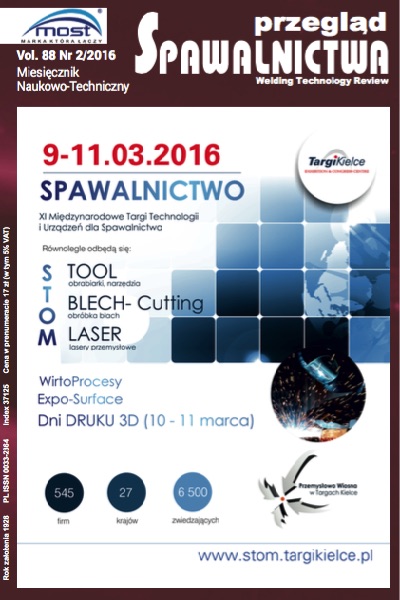Wpływ warunków wykonania napoin na własności stali ARMOX 370T w obszarze wokół napoiny
Main Article Content
Abstract
Przedstawiono zmianę rozkładu twardości stali ulepszanej cieplnie (pancernej) ARMOX 370T Class 2 w obszarze napoiny wykonanej metodą MAG drutem SG2 oraz drutem G18 8 Mn. W przeprowadzonych eksperymentach napoiny reprezentują różne klasy spoin sczepnych zarówno pomiędzy elementami z tego samego materiału, jak i spoiny sczepne pomiędzy elementami wykonanymi ze stali ARMOX 370T Class 2, a przyrządami usztywniającymi i montażowymi wykonanymi ze stali konstrukcyjnej. Zmiennymi parametrami procesu napawania były: temperatura podgrzewania wstępnego, rodzaj materiału dodatkowego, długość napoiny oraz energia liniowa napawania. Monitorowano także parametry spawania. Wykonane napoiny poddano ocenie wizualnej, badaniom metalograficznym makroskopowym i mikroskopowym oraz zbadano rozkład twardości w obszarze napoin. Wyniki badań wskazały, że w celu ograniczenia twardości w obszarze wokół napoiny (spoiny sczepnej) jej długość powinna wynosić co najmniej 25 mm. Podgrzewanie wstępne do napawania i stosowania niskiej energii liniowej napawania także powoduje obniżenie twardości w materiale rodzimym wokół napoiny (spoiny sczepnej). Gatunek zastosowanego drutu nie wpływa na maksymalne wartości twardości w obszarze napoiny.
Influence of the tack weld welding conditions
on ARMOX 370T steel properties in the weld area
Abstract
The article presents the change in the distribution of hardness of ARMOX 370T Class 2 steel in the area around the bead on plate weld made by GMA SG2 wire and G18 8 Mn wire. In the experiments welds represent different classes of tack welds between elements of the same material and tack welds between elements made of steel ARMOX 370T Class 2 and the stiffening and mounting devices made of structural steel. Welding variable were: preheat temperature, type of filler metal, length of weld and heat input. Welding parameters were monitoring during the welding. Tack welds were examined visually and cross section of welds were observed on microscope at macro and micro magnification. Also hardness distribution in the area around weld was tested. Results of tests show that the length of bead on plate (tack weld) should be at least 25 mm to keep the hardness in acceptable limits. Preheating and low heat input in also results in lowering the hardness in the base metal near weld. Type of welding wire does not influence the maximum value of hardness in the area of weld.
Downloads
Article Details
Creative Commons CC BY 4.0 https://creativecommons.org/licenses/by/4.0/
Welding Technology Review (WTR) articles are published open access under a CC BY licence (Creative Commons Attribution 4.0 International licence). The CC BY licence is the most open licence available and considered the industry 'gold standard' for open access; it is also preferred by many funders. This licence allows readers to copy and redistribute the material in any medium or format, and to alter, transform, or build upon the material, including for commercial use, providing the original author is credited.
References
L.Kuzmikova, H.Norrish, J.Pan: Development of safe optimized welding procedures for high strength Q&T steel welded with austenitic consumalbes. Revista Soldagem e Inspecao, nr 18 (2), 2013, str. 169÷175.
I.Barenyi, O.Hires, P.Liptak: Degradation of mechanical properties of armored steels after its welding. Materiały konferencyjne International Conference of Scientific Paper Afases, Brasov, 26-28 maj, 2011, str. 845÷848.
I.Barenyi, O.Hires, P.Liptak: Over tempering of Armox armored steels at after secondary processing. Materiały konferencyjne International Conference of Scientific Paper Afases, Brasov, 24-26 maj, 2012.
R.Willms: High strength steel for constructions. Materiały konferencyjne Nordic Steel Construction Conference, 2-4 października, Malmo, Szwecja 2009.
F. Schroter, T. Lehnert: Trends in the application of highperformance steel in European bridge building. Materiały konferencyjne The Eight International Conference Bridges in Danube Basin, 2013, str. 35÷50.
E.Brezova, H.Masiar, P.Radic: Welding of high strength materials used in the manufacture special equipment. University Review, tom 8, nr 3-4, 2014, str. 51÷61.
G. Magudeeswaran, V. Balasubramanian, R.G. Madhusudhan: Hydrogen induced cold cracking studies on armour grade high strength, quenched and tempered steel weldments, International Journal of Hydrogen Energy 33/2008, str. 1897÷1908.
SSAB, Inc.: Armox Protection Plate. Workshop Recommendations [online]. [Dostępny 25 stycznia 2015]. Dostępny w internecie: http:// www.ssab.com/Global/Armox/Brochures/en/701-Armox_Work- shop%20recommendations.pdf.
M.Gaspar, A.Balogh: GMAW Experiments for advanced Q+T high strength steels, Production Processes and Systems, tom 6, nr 1, 2013, str. 9÷24.
K.Hakansson: Weld Metal Properties for Extra High Strength Steels. Praca Doktorska, ISSN 1650 1888, Division of Welding; Department of Production Engineering; The Royal Institute of Technology, sierpień 2002.
Ryszard Karcz, Sławomir Kwiecień, Marian Godniak, Ryszard Jastrzębski Spawanie stali wysokowytrzymałych cz. II Projektowanie i konstrukcje inżynierskie, nr 9, 2013.12.
PN-EN 10025:6+A1:2009: Wyroby walcowane na gorąco ze stali konstrukcyjnych Część 6:Warunki techniczne dostawy wyrobów płaskich o podwyższonej granicy plastyczności w stanie ulepszonym cieplnie.
SSAB, Inc.: Armox 370T Protection Plate [online]. [dostęp 25 stycznia 2015]. Dostępny w internecie: http://www.ssab.com/en/Brands/ Armox/Products/Armox-370T-Class-2/#
D.Schroepfer, A.Kromm, T.Kannengiesser: Improving welding stresses by filler metal and heat control selection in component related butt joints of high strength steel. Welding in the World, styczeń 2015.
